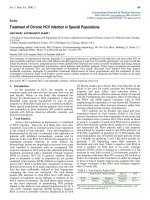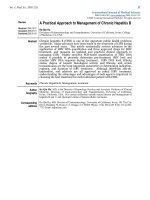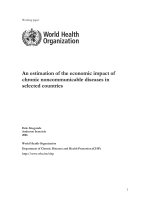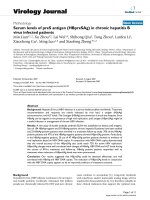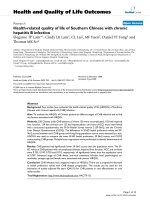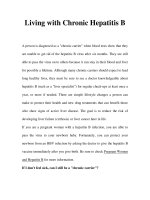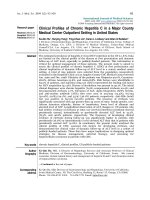longterm outcome of chronic hepatitis b in causasian pts - mortality after 25 years 2008
Bạn đang xem bản rút gọn của tài liệu. Xem và tải ngay bản đầy đủ của tài liệu tại đây (338.52 KB, 8 trang )
doi:10.1136/gut.2007.128496
2008;57;84-90; originally published online 22 Aug 2007; Gut
G Fattovich, N Olivari, M Pasino, M D’Onofrio, E Martone and F Donato
Caucasian patients: mortality after 25 years
Long-term outcome of chronic hepatitis B in
/>Updated information and services can be found at:
These include:
References
/>This article cites 28 articles, 3 of which can be accessed free at:
service
Email alerting
the top right corner of the article
Receive free email alerts when new articles cite this article - sign up in the box at
Notes
/>To order reprints of this article go to:
/> go to: GutTo subscribe to
on 11 August 2008 gut.bmj.comDownloaded from
Long-term outcome of chronic hepatitis B in
Caucasian patients: mortality after 25 years
G Fattovich,
1
N Olivari,
1
M Pasino,
1
M D’Onofrio,
2
E Martone,
2
F Donato
3
1
Department of
Gastroenterology, University of
Verona, Verona, Italy;
2
Department of Radiology,
University of Verona, Verona,
Italy;
3
Institute of Hygiene,
Epidemiology and Public Health,
University of Brescia, Brescia,
Italy
Correspondence to:
Dr G Fattovich, Unita` Operativa
di Gastroenterologia,
Dipartimento di Scienze
Chirurgiche e
Gastroenterologiche, Universita`
di Verona, Piazzale L.A. Scuro n.
10, 37134 Verona, Italy;
Revised 5 August 2007
Accepted 15 August 2007
Published Online First
22 August 2007
ABSTRACT
Objective: To assess risk factors for liver-related death,
we re-evaluated, after a median follow-up of 25 years, a
cohort of 70 Caucasian patients with hepatitis B e antigen
(HBeAg) positive chronic hepatitis (CH) at presentation.
Methods: Follow-up studies included clinical and ultra-
sound examinations, biochemical and virological tests,
and cause of death.
Results: Sixty-one (87%) patients underwent sponta-
neous HBeAg seroconversion. During a median period of
22.8 years after HBeAg seroclearance, 40 (66%) patients
became inactive carriers, whereas the remaining 21
(34%) showed alanine aminotransferase elevation: one
(1%) had HBeAg reversion, nine (15%) detectable serum
HBV DNA but were negative for HBeAg, eight (13%)
concurrent virus(es) infection and three (5%) concurrent
non-alcoholic fatty liver disease. Liver-related death
occurred in 11 (15.7%) patients, caused by hepatocellular
carcinoma in five and liver failure in six. The 25-year
survival probability was 40% in patients persistently
HBeAg positive, 50% in patients with HBeAg negative CH
or HBeAg reversion and 95% in inactive carriers. Older
age, male sex, cirrhosis at entry and absence of sustained
remission predicted liver-related death independently. The
adjusted hazard ratios (95% CI) for liver related death
were 33 (3.01–363) for persistently HBeAg positive
patients and 38.73 (4.65–322) for those with HBeAg
negative CH or HBeAg reversion relative to inactive
carriers.
Conclusion: Most patients with HBeAg seroconversion
became inactive carriers with very good prognosis. The
risk of liver-related mortality in Caucasian adults with CH
is strongly related with sustained disease activity and
ongoing high level of HBV replication independently of
HBeAg status.
Chronic hepatitis B virus (HBV) infection is an
established cause of liver-related morbidity and
mortality and represents a major global public health
problem.
12
Studies conducted in Asian regions of
high HBV endemicity have estimated that up to 40%
of individuals with chronic HBV infection will
progress to liver cirrhosis, end-stage liver disease or
hepatocellular carcinoma (HCC) during their life-
time and that HBV-related liver disease contribute to
approximately 20 deaths per 100 000 population
each year.
34
The long-term liver-related morbidity
and mortality of chronic hepatitis B in untreated
Caucasian patients and predictors of survival deserve
further evaluation. In fact, the prognostic value of
sustained high levels of HBV replication on survival
in untreated Caucasian patients is limited to cohorts
of patients with cirrhosis.
5–7
We conducted this longitudinal study to eluci-
date the long-term survival according to virological
pattern in a cohort of north Italian patients with
chronic hepatitis B who had high levels of HBV
replication (HBeAg positive) at diagnosis, during a
median period of 25 years.
PATIENTS AND METHODS
Patients
A longitudinal study began in Padova, northern
Italy, enrolling between 1972 and 1984 seventy
consecutive hepatitis B surface antigen (HBsAg)
and HBeAg positive patients, 49 male and 21
female with a median age of 29 years and with
biopsy proven chronic hepatitis (8 (11.4%) with
cirrhosis) at presentation. The clinical, virological
and histological details of the study population at
entry and the natural history of the disease during
a mean follow-up period of 5.0 years (SD 2.3 years)
were described previously.
8
The follow-up of this
cohort of patients has been performed at the
Department of Gastroenterology at Verona
University Hospital in northern Italy and updated
through June 2006.
Follow-up data were obtained during regular
clinical controls, on average every 6 months for
patients who remained HBeAg positive or sero-
converted from HBeAg to anti-HBe, but main-
tained or developed abnormal ALT levels and on
everage every 12 months for inactive HBsAg
carriers. By 1986 it became clear that HBeAg
seroclearance with ALT normalisation is usually
associated with histology improvement,
8
thus in
the subsequent years follow-up liver biopsies were
performed only in patients with active hepatitis.
Patients who did not undergo the regular controls
were traced through the municipality registries and
were phoned and asked to attend again the clinic
for evaluation. People who refused to attend the
clinic again were interviewed by phone and asked
to provide laboratory and liver ultrasound exam-
inations with the consent of their family doctors.
Data on patients’ liver-related or other diseases
that had been collected through the phone inter-
views were cross-checked with the archives of their
family doctors. The causes of death for those
deceased were ascertained by retrieving the death
certificates. We were able to trace all patients
except two (97.1%) from the initial cohort. The
current study was approved by the Verona
Hospital Ethics Committee.
Definition of clinical events
The time of observation was calculated from the
date of entry into the study until death, liver
transplantation or the last observation. The
primary outcome was liver related mortality. The
occurrence of cirrhosis during follow-up was
Hepatitis
84 Gut 2008;57:84–90. doi:10.1136/gut.2007.128496
on 11 August 2008 gut.bmj.comDownloaded from
defined by histology or ultrasonography features suggestive of
cirrhosis based on a quantitative scoring system derived from
the appearance of the liver margins, parenchymal echotexture,
portal vein calibre and spleen diameter,
910
supplemented with
the presence of oesophageal varices or ascites. HCC diagnosis
was based on the following criteria: a histopathological
examination; a positive lesion detected by at least two different
imaging techniques (abdominal ultrasonography, computerised
tomography, or angiogram); a positive lesions detected by one
imaging technique and a-fetoprotein levels exceeding 400 mg/l.
Biochemical remission was defined as the normalisation of
serum ALT levels on at least two consecutive determinations
obtained at least 3 weeks apart and persisting at last observa-
tion. After HBeAg seroclearance with anti-HBe seroconversion,
patients were defined as inactive HBsAg carries when ALT
values were persistently normal and HBV DNA was persistently
negative according to non-polymerase chain reaction (PCR)
assays (detection limit, 1.4610
5
copies/ml). Active hepatitis,
after HBeAg seroclearance, was defined as ALT elevation over
twice the upper normal value on at least two consecutive
determinations obtained at least 3 weeks apart. HBeAg negative
hepatitis was diagnosed when abnormal ALT and HBV DNA
seropositivity by non-PCR assays persisted continuously or
recurred intermittently after HBeAg seroclearance.
Laboratory procedures
HBsAg, antibody to HBsAg (anti-HBs), HBeAg, antibody to
HBeAg (anti-HBe), hepatitis delta virus (HDV) and hepatitis C
virus (HCV) antibodies, hepatitis A virus IgM antibodies were
detected by conventional serological assays. Serum HBV DNA
was first tested by homemade spot hybridisation with a
detection limit of 0.1 pg/ml,
8
then the Digene Hybrid Capture
System assay (Digene, Beltsville, MD) was used, with a
detection limit of 0.5 pg/ml (1.4610
5
copies/ml). More recently
HBV DNA was tested with a commercial PCR assay (Cobas
Amplicor HBV Monitor, Roche, Basel, Switzerland) with a
detection limit of 200 copies/ml.
Serum HDV RNA was detected by an ‘‘in-house’’ reverse-
transcriptase PCR (RT-PCR) in the virology laboratory of the
University Hospital of Verona. Briefly, HDV RNA was
extracted from 200 ml of serum, reverse transcribed and
amplified by one-step RT-PCR in a final volume of 50 ml using
a set of primers derived from the carboxyterminal portion of the
genomic region coding for the HDV antigen (primers 59 R 39,
position 886–909 and 1331–1310, respectively). The amplifica-
tion products were visualised on a 2% agarose gel stained with
ethidium bromide. For each test sample a negative and a
positive control were included in parallel throughout the entire
procedure. Serum HCV RNA was first measured by an ‘‘in-
house’’ nested RT-PCR with a detection limit of 100 copies/
ml,
11
then was assessed using a commercial PCR assay (Cobas
Amplicor HCV Monitor, Roche, Basel, Switzerland).
Histological diagnosis was defined according to international
criteria.
12 13
Statistical analysis
The Mann–Whitney and x
2
and exact tests were used for
comparison of continuous and categorical variables between
two independent groups. p values lower than 0.05 in two-tailed
tests were considered as significant.
The cumulative probabilities of survival were analysed by the
Kaplan–Meier method
14
and comparison between groups was
performed by using the log-rank test.
15
Patients who died from
causes that were not related to liver disease or were lost to
follow-up or responded to antiviral therapy were censored at
the time of death, drop out or response to antiviral therapy,
respectively. Multivariate analysis was also performed by fitting
the Cox proportional hazard models in order to evaluate the role
of each prognostic factor when controlling for the others. The
assumption of proportionality of hazards functions was
assessed using graphical methods as suggested.
16
Statistical analyses were performed using the STATA soft-
ware (Stata Statistical Software release 8.0, 2003; Stata
Corporation, College Station, Texas).
RESULTS
Serological outcome
HBeAg seroconversion
Our cohort of 70 HBeAg positive patients was followed for a
median period of 25.3 years (range, 1.3–33.1) for a total of 1564
person-years. During this observation period nine (12.8%)
patients remained persistently HBeAg positive and 61 (87.2%)
underwent spontaneous HBeAg seroclearance with anti-HBe
seroconversion (fig. 1). The cumulative probabilities of HBeAg
seroconversion were 64%, 93% and 97% at 5, 10 and 25 years of
follow-up, respectively. Most patients underwent HBeAg
seroconversion during the first 10 years of the study (58 of 61,
95.1%), with an incidence rate of 18.7 per 100 person-years. At
enrolment, patients who remained persistently HBeAg positive
were older (median age, 51 vs. 27 years) and had a higher
prevalence of cirrhosis (44% vs. 6.6%) as compared with those who
underwent spontaneous HBeAg seroclearance (table 1). At the
time of HBeAg seroconversion, their median age was 30 years
(range, 16–65) and 11 (18%) had histological evidence of cirrhosis.
The 61 patients with HBeAg seroclearance were followed for
a median period of 22.8 years (range, 0.5–28.4) after HBeAg
seroconversion. Forty (66%) out of the 61 patients had
sustained ALT normalisation and undetectable HBV DNA by
non-PCR tests and were considered inactive carriers; more
recently HBV DNA was tested by PCR assay in 15 (37.5%) out
of the 40 inactive carriers and was detectable in all cases ranging
from 700 to 9800 copies/ml. The remaining 21 (34%) out of the
61 patients experienced active hepatitis; among these 21
patients, ALT elevation was associated with HBeAg reversion
in one (1%), detectable serum HBV DNA but HBeAg negative
(HBeAg negative hepatitis) in nine (15%), concurrent HCV and/
Figure 1 Study flow diagram. NAFLD, non-alcoholic fatty liver disease.
Hepatitis
Gut 2008;57:84–90. doi:10.1136/gut.2007.128496 85
on 11 August 2008 gut.bmj.comDownloaded from
or HDV infection in eight (13%) and concurrent non-alcoholic
fatty liver disease (NAFLD) in three (5%) cases (fig. 1). Of the
three patients with NAFLD, two had histological features of
non-alcoholic steatohepatitis (NASH) and one was obese (BMI
38 kg/m
2
) with fatty liver diagnosed by ultrasound. All three
cases with NAFLD were seronegative for both HBeAg and HBV
DNA by non-PCR tests; at the last visit HBV DNA was
detectable by PCR ranging from 300 to 8750 copies/ml.
The clinical and biochemical features of the 61 patients with
spontaneous HBeAg seroconversion according to clinical and
serologic categories during follow-up (40 with sustained
remission and 21 with active hepatitis) are given in table 2.
The patients who developed HBeAg negative hepatitis or
HBeAg reversion had a higher prevalence of cirrhosis at the
time of HBeAg seroconversion compared to patients with
sustained remission (50% vs. 17.5%, respectively; p = 0.04)
(table 2).
HBsAg loss
Eighteen (45%) of the 40 inactive carriers and one (12.5%) of the
eight patients with viral concurrent infections lost their HBsAg
and developed the related antibody (table 2). The incidence of
HBsAg loss was 2.1 per 100 person-years in inactive carriers.
Among the 18 inactive carriers with HBsAg loss the median
interval between HBeAg seroconversion and HBsAg clearance
was 13.8 years (range, 1.1–26.9).
Clinical outcome
Patient survival
A total of 50 patients were alive at the end of the follow-up:
among them, 30 (60%) were checked into the hospital, 18 (36%)
were interviewed by phone and two were lost at the follow-up.
Liver-related death occurred in 11 (15.7%) patients, caused by
HCC in five and liver failure in six, and one patient underwent
OLT for end-stage liver disease (table 1).
The cumulative probability of survival among all patients was
90% and 86% at 10 and 25 years of follow-up, respectively.
The cumulative probability of survival at 25 years was
significantly lower in the nine patients who remained HBeAg
positive (40%) and in patients developing HBeAg negative
hepatitis or HBeAg reversion (50%) as compared to inactive
carriers (95%) (p,0.0001) (fig. 2). None of the patients with
concurrent HCV and/or HDV infection or patients with
concurrent NAFLD died during the 25 years of observation.
The cumulative probability of survival at 25 years was
significantly lower in eight patients with cirrhosis at entry
(22.5%) and in 17 patients who developed cirrhosis during
follow-up (59%) as compared to 45 patients without cirrhosis
(100%) (p,0.0001).
Cox proportional hazard regression model showed that older
age at diagnosis, male sex, the presence of cirrhosis at enrolment
and the absence of sustained remission during follow-up were
significantly associated with an increased risk for liver related
death or OLT (table 3). In a subgroup analysis excluding
patients with concurrent HCV and/or HDV infection or
NAFLD, the risk of liver related mortality or OLT was increased
33-fold in patients with HBeAg persistence and 38-fold in those
with HBeAg negative hepatitis or HBeAg reversion as compared
to patients with sustained remission (inactive carriers) (table 3).
Antiviral therapy
Ten patients with evidence of high levels of HBV replication
(two HBeAg positive and eight with HBeAg negative hepatitis)
were still alive in the late 1980s when interferon (IFN) therapy
became available and three of them (one HBeAg positive and
two HBeAg negative) were treated with IFN. An additional four
out of the eight patients with concurrent viral concurrent
Table 1 Demographic and clinical features of different subsets of the study population at enrolment and
during follow-up
All patients HBeAg persistence HBeAg seroclearance
No. patients
70 9 61
Features at entry
Age (years) (median, range)
29 (15–64) 51 (26–64) 27 (15–62)
Male
49 (70) 7 (77.8) 41 (67.2)
ALT 6 normal (median, range)
2.9 (2–16) 2.7 (2–4.2) 3.0 (2–16)
Previous acute hepatitis
30 (42.9) 4 (44.4) 26 (42.62)
Presumed source of infection
Intravenour drug use
3 (4.3)
0
3 (4.9)
Transfusion
7 (10.0) 2 (22.2) 5 (8.2)
Medical occupation
13 (18.6)
0
13 (21.3)
Household contact
17 (24.3)
0
17 (27.9)
Community life
3 (4.3)
0
3 (4.9)
Unknown
27 (38.6) 7 (77.8) 20 (32.8)
Presence of cirrhosis
8 (11.4) 4 (44.4) 4 (6.6)
Features during follow-up
Cirrhosis occurrence
17 (24.3) 4 (44.4) 13 (21.3)*
Total number of deaths
19 (27.1) 7 (77.8) 12 (19.7)
Liver-related deaths
11 (15.7) 5 (55.6) 6 (9.8)
HCC
5 (7.1) 1 (11.1) 4 (6.6)
Liver failure
6 (8.6) 4 (44.4) 2 (3.3)
Non-liver related deaths
8 (11.4) 2 (22.2) 6 (9.8)
OLT
1 (1.4)
0
1 (1.6)
Drop out
2 (2.9)
0
2 (3.3)
Data expressed as number (%).
ALT, alanine aminotransferase; OLT, orthotopic liver transplantation.
*Seven patients developed cirrhosis before HBeAg seroclearance and six patients after HBeAg seroclearance.
Hepatitis
86 Gut 2008;57:84–90. doi:10.1136/gut.2007.128496
on 11 August 2008 gut.bmj.comDownloaded from
infections received antiviral therapy. Among the seven treated
patients, two (one HBeAg positive and one HBV/HCV co-
infected patient) responded to antiviral therapy and were
censored from follow-up. The details of IFN schedule and
reasons for not treating the remaining patients are provided in
the following sections.
Clinical outcome of HBeAg positive patients
Among the nine patients who remained HBeAg positive during
a median follow-up period of 6.8 years (range, 1.3–25), eight had
histologically documented cirrhosis (four diagnosed at entry and
four during follow-up). One patient (with cirrhosis diagnosed
during follow-up) responded to lymphoblastoid IFN at the dose
of 8 million units thrice weekly for 6 months in the year 1989.
The remaining seven patients with cirrhosis died: four for
decompensated cirrhosis, one for HCC and two for liver
unrelated causes. Among these seven patients, six died in the
early 1980s before antiviral therapy became available and one
did not receive IFN therapy due to ischaemic heart disease
which was the cause of unrelated death in 1999. Only one
(1.4%) of the 70 initially HBeAg positive patients is still HBeAg
positive and alive without clinical and/or serological evidence of
Table 2 Clinical and biochemical features in 61 patients with spontaneous HBeAg seroconversion according to clinical and serological categories
during follow-up (40 with sustained remission and 21 with active hepatitis)
Sustained remission
HBeAg-/HBV-DNA+
or HBeAg reversion
HDV and/or HCV
concurrent infection NAFLD
No. patients 40 10 8 3
Features at entry
Age (years) (median, range)* 29.5 (15–52) 24 (15–62) 23.5 (15–39) 15 (13–21)
Male* 25 (62.5) 8 (80) 6 (75) 3 (100)
ALT 6 normal (median, range)* 3.4 (2–10.9) 2.5 (2–9.2) 3.1 (2–16) 2.1 (2–2.4)
Features during follow-up
Follow-up after HBeAg seroconversion (years) (median, range){ 23.0 (3.2–28.2) 18.2 (2.8–25.9) 19.4 (0.5–28.4) 20.8 (20.8–24.3)
Age at HBeAg seroconversion (year) (median, range)* 33 (17–59) 28 (17–65) 30.5 (19–31) 22 (16–25)
Cirrhosis at HBeAg seroconversion{ 7 (17.5) 5 (50) 1 (12.5) 0
Alive 32 (80) 5 (50) 8 (100) 3 (100)
Clinical and laboratory assessment 15 (37.5) 4 (40) 6 (75) 3 (100)
Telephone interview 16 (40) 1 (10) 1 (12.5) 0
Drop out 1 (2.5) 0 1 (12.5) 0
Total number of deaths* 8 (20) 4 (40) – –
Liver-related deaths1 2 (5) 4 (40) 0 0
HCC* 2 (5) 2 (20) 0 0
Liver failure{ 0 2 (20) 0 0
Non-liver related deaths 6 (15) 0 0 0
OLT 0 1 (10) 0 0
HBsAg loss 18 (45) 0 1 (12.5) 0
Data are expressed as number (%).
HDV, hepatitis delta virus; HCV, hepatitis C virus; NAFLD, non-alcoholic fatty liver disease; ALT, alanine aminotransferase; HCC, hepatocellular carcinoma; OLT, orthotopic liver
transplantation.
Comparison between 40 patients with sustained remission and 10 patients with HBeAg negative hepatitis (HBeAg2/HBV DNA+) or HBeAg reversion (HBeAg+/HBV DNA+): *Not
significant; {p =0.05; {p =0.04; 1p =0.002.
Figure 2 Cumulative probability of
survival in the three subsets of patients:
inactive carriers, patients with HBeAg
negative hepatitis or HBeAg reversion and
patients persistently HBeAg positive
(p,0.0001, log-rank test).
Hepatitis
Gut 2008;57:84–90. doi:10.1136/gut.2007.128496 87
on 11 August 2008 gut.bmj.comDownloaded from
cirrhosis at the last observation in June 2006; the patient had
ALT fluctuating from normal to 1.5 times the upper normal
value during follow-up and remained untreated.
Clinical outcome of inactive carriers
The clinical outcome of the 40 inactive carriers during a median
follow-up period of 23 years (range, 3.2–28.2) after HBeAg
seroconversion is shown in fig. 3. Seven patients had histolo-
gically documented cirrhosis, three at enrolment and four
progressed to cirrhosis during the HBeAg positive phase before
HBeAg seroconversion. Of these seven inactive carriers with
cirrhosis, two died from HCC 7.7 and 9.4 years after HBeAg
seroconversion, respectively, three died of liver-unrelated causes,
one is alive and one was lost to follow-up. Of the 33 inactive
carriers without cirrhosis, three died of liver unrelated causes
and the remaining 30 are alive.
Clinical outcome of patients with active hepatitis after HBeAg
seroclearance
The clinical outcome of the 21 patients with HBeAg seroclear-
ance and active hepatitis is illustrated in fig. 4.
One patient with cirrhosis at enrolment showed HBeAg
reversion associated with persistent ALT elevation 15 months
after HBeAg seroconversion and died of liver failure 3.9 years
after sustained HBeAg reversion.
Among the nine patients who progressed to HBeAg negative
hepatitis two had histologically documented cirrhosis at the
time of HBeAg seroconversion and two developed clinical
cirrhosis 3 and 13 years after HBeAg seroconversion, respec-
tively. Among the four patients with cirrhosis, one died of liver
failure in the year 1981, one did not respond to lymphoblastoid
IFN (8 million units thrice weekly for 6 months) in the year
1987 and underwent OLT 11 years later and the remaining two
patients remained untreated because of advanced cirrhosis with
low platelet levels at the time IFN therapy became available and
died of HCC. All five patients with HBeAg negative hepatitis
without cirrhosis are alive. All five patients underwent follow-
up liver biopsies after development of HBeAg negative hepatitis
showing mild to moderate chronic hepatitis without cirrhosis
and none showed liver surface nodularity or other ultrasono-
graphic markers of advanced liver disease at follow-up
ultrasound examination. One patient failed to respond to
lymphoblastoid IFN (8 million units thrice weekly for
6 months) and the other four remained untreated because of
mild histology and no clinical evidence of progressive disease.
Of the eight patients with concurrent viral infections, five
developed cirrhosis (histologically confirmed in four cases)
during follow-up (one during the HBeAg positive phase and
four after HBeAg seroconversion) and three had no clinical, liver
ultrasonographic and/or biochemical evidence of cirrhosis at the
last observation. Of the five patients with cirrhosis, one HBV/
HCV infected patient responded to standard combination
treatment with pegylated IFN-a and ribavirin, two anti-HDV/
anti-HCV positive (HCV RNA negative) patients failed to
respond to recombinant IFNa2a (10 million units thrice weekly
for 12 months), one anti-HDV/anti-HCV positive (HDV RNA,
HCV RNA and HBV DNA negative by PCR at last observation)
patient admitted alcohol abuse and was advised to abstain from
alcohol intake and the remaining anti-HDV positive (HDV RNA
negative at last observation) patient showed intermittently
slightly elevated ALT and remained untreated. Of the three
patients without cirrhosis, one anti-HDV positive patient was
lost to follow-up, one HBV/HCV infected patient lost HBsAg
and refused antiviral therapy for HCV and the remaining HBV/
HCV infected patient failed to respond to standard combination
therapy with recombinant IFN-a and ribavirin. Excluding one
anti-HDV positive patient lost to follow-up and one anti-HCV
positive patient who responded to antiviral therapy and
censored from follow-up, the remaining six patients are alive
and without evidence of hepatic complications in those with
cirrhosis.
None of the patients with active hepatitis after HBeAg
seroclearance received nucleoside or nucleotide therapy.
DISCUSSION
The major aim of this longitudinal study was to assess the
prognostic significance of sustained high HBV replication levels
on the risk of liver-related death in a cohort of 70 Caucasian
patients with HBsAg and HBeAg positive chronic hepatitis at
diagnosis who were followed for a median period of 25 years
with a very low drop-out rate. The number of patients is
relatively small, but the study population consists of a well-
defined cohort of consecutive patients previously described,
8
thus minimising the risk of selection bias. Data on liver-related
Table 3 Hazard ratios (HR) and 95% confidence intervals (CI) for liver related death by Cox proportional
hazard regression models (all variables included in the model)
Variable No. patients
No. liver-related
deaths/OLT HR (95% CI) p
Age at entry (years)
70 12 1.10 (1.06 to 1.16)
,0.001
Sex
Female
21 1 1
Male
49 11 23.38 (1.95 to 280.3)
,0.01
Duration of HBeAg positive phase (years)
70 12 0.84 (0.63 to 1.10)
n.s.
Cirrhosis at entry
No
62 6 1
Yes
8 6 13.90 (2.58 to 74.81
0.002
Sustained remission 0.02
Yes
40 2 1
No
30 10 27.04 (2.58 to 74.82)
0.002
Sustained remission*
40 2 1
HBeAg2/HBV DNA+ or HBeAg reversion
10 5 38.73 (4.65 to 322.9)
0.001
HBeAg persistence
9 5 33.06 (3.01 to 363.0)
0.004
n.s., not significant.
*The model included the 40 patients with sustained remission (reference category), the 10 patients with HBeAg2/HBV DNA+
chronic hepatitis or HBeAg reversion and the nine patients with HBeAg persistence, and adjusted for age, sex and cirrhosis at entry.
Hepatitis
88 Gut 2008;57:84–90. doi:10.1136/gut.2007.128496
on 11 August 2008 gut.bmj.comDownloaded from
mortality were accurately obtained in the great majority (97%)
of patients. After 25 years, survival was significantly worse in
patients who remained HBeAg positive, developed HBeAg
negative hepatitis or HBeAg reversion, as compared with
inactive carriers (40%, 50% and 95%, respectively). It is of note
that the adjusted hazard ratios for liver-related death were 33-
fold higher in patients who remained HBeAg positive and 38-
fold higher in HBeAg negative hepatitis who had HBV DNA
positivity or HBeAg reversion with respect to inactive carriers.
To our knowledge, data regarding the relationship between
ongoing HBV replication and liver related mortality in the West
are limited to patients who have already progressed to
cirrhosis.
5–7
Studies conducted in tertiary care centres in
Europe among patients with compensated cirrhosis showed
that those with persistently high levels of HBV replication, as
indicated by HBeAg positivity, have increased liver related death
rates, of about 2-fold, as compared to those who clear HBeAg
with biochemical remission.
5
Early studies on the natural
history of chronic hepatitis B in Caucasian patients do not
provide information whether HBeAg seroconversion leads to a
decreased risk of liver-related adverse events and mortality, due
to the too short follow-up period of 5 years at most
81718
A prospective population-based cohort study in HBsAg
positive Chinese patients has reported that high viral load at
baseline (>105 copies/ml) is significantly associated with
increased mortality from HCC and chronic liver disease over a
11-year period.
19
However, these findings should be considered
with caution because only baseline measures of HBV DNA level
were tested, which are poorly related with the levels of HBV
replication and disease activity during the whole follow-up of an
individual. Only one prospective study from Asia monitored
serum HBV DNA over time and showed that patients with
sustained elevation of HBV DNA had the highest HCC risk,
20
but data on the risk of liver-related mortality were not reported.
This is the first long-term longitudinal study in untreated
adult Caucasian patients with chronic hepatitis B (89% without
cirrhosis at diagnosis) showing that ongoing high level of HBV
replication during follow-up is associated with significantly
increased risk of liver-related mortality. In our study the
inactive carrier was defined by sustained normal ALT and
HBV DNA persistently negative by non-PCR assays, thus
including a heterogeneous group of patients who may have up
to 1.4610
5
copies/ml of HBV DNA. Nevertheless we showed
that HBeAg negative patients with sustained normal ALT and
HBV DNA levels of less than 1.4610
5
copies/ml have a very
good prognosis with long life expectancy. Our data suggest that
recent findings from cohort studies in Chinese subjects in their
40s with perinatally or early childhood acquired HBV infection
(85% of cohort HBeAg negative, 94% with normal ALT) that
serum HBV DNA levels above 10
4
copies/ml increase the risk for
cirrhosis and HCC regardless of serum ALT levels and HBeAg
status
20 21
can not be directly referred to Caucasian patients.
Figure 3 Flow diagram of the clinical outcome of 40 inactive carriers.
HCC, hepatocellular carcinoma.
a
Three patients had cirrhosis at
enrolment and four developed cirrhosis before HBeAg seroclearance.
Figure 4 Flow diagram of the clinical
outcome of 21 patients with active
hepatitis after HBeAg seroclearance.
NAFLD, non-alcoholic fatty liver disease;
NASH, non-alcoholic steatohepatitis;
HCV, hepatitis C virus; HDV, hepatitis
delta virus; OLT, orthotopic liver
transplantation; HCC, hepatocellular
carcinoma.
a
Cirrhosis at enrolment.
b
Two
of the four patients developed cirrhosis
after HBeAg seroclearance.
c
Four of the
five patients developed cirrhosis after
HBeAg seroclearance.
d
Responder to
pegylated interferon and ribavirin.
Hepatitis
Gut 2008;57:84–90. doi:10.1136/gut.2007.128496 89
on 11 August 2008 gut.bmj.comDownloaded from
Differences in long-term outcomes between Asian and
Caucasian patients should be taken into account in current
recommendations for management and treatment of chronic
hepatitis B.
122
Notably, our data are in accordance with a recent longitudinal
study of 91 HBeAg positive Italian children showing that 81
(95%) of 85 children without cirrhosis at enrolment and who
underwent spontaneous HBeAg seroconversion remained inac-
tive carriers after 29 years follow-up and none died.
23
However,
of the four children with cirrhosis two remained inactive
carriers and two developed HCC 9 and 16 years after HBeAg
seroconversion.
23
In our study two inactive carriers who had
already developed cirrhosis during the HBeAg positive phase,
died of HCC 8 and 9 years after HBeAg seroconversion. These
findings underline the clinical relevance of HBeAg seroconver-
sion with virological and biochemical remission early in the
course of the liver disease before cirrhosis occurrence.
In addition to the main findings on survival, this study
provides some data on the long-term rates of serological events.
The incidence of HBeAg seroconversion was 18.7 per 100
person-years in the first 10 years of the follow-up and the
incidence of HBsAg seroconversion was 2.1 per 100 person-years
in accordance with previous studies from Western countries in
adults patients.
1 2 18 24–26
Our study shows that 34% of patients developed active
hepatitis despite HBeAg seroconversion: nine patients (15%)
showed HBeAg negative hepatitis and one (1%) showed HBeAg
reversion. The patients who developed HBeAg negative hepa-
titis had a significantly higher prevalence of cirrhosis at the time
of HBeAg seroconversion as compared with inactive carriers.
These results are in agreement with an Asian study by Hsu
et al,
27
reporting that 33% of patients with spontaneous HBeAg
seroconversion experienced ALT elevation during a median
follow-up period of 8.6 years, associated with HBeAg negative
hepatitis in 24% of cases and with HBeAg reversion in 4%. In
the same study, the patients with liver cirrhosis at the time of
HBeAg seroconversion had a 10-fold increased risk of developing
HBeAg negative hepatitis. Overall these data support the view
that HBeAg negative chronic hepatitis represents a late phase in
the natural history of chronic HBV infection.
Concurrent HCV and/or HDV infection was found in a small
proportion (13%) of our patients with active hepatitis after
HBeAg seroconversion and did not seem to affect the natural
history of chronic hepatitis B. The complex viral interplay in
cases of dual or triple infection
28
may provide an explanation to
the clinical evidence in longitudinal studies that HBV/HDV co-
infection is not always associated with a more severe disease
than HBV infection alone
6
and that HBV/HCV concurrent
infection is not always associated with a higher risk of HCC
than in either infection alone.
29
In conclusion, the present long term study in Caucasian
patients with chronic hepatitis B shows that most patients
become inactive carriers after spontaneous HBeAg seroconver-
sion and this condition confers survival benefit with regard to
liver disease mortality, particularly if present before the onset of
cirrhosis. HBeAg reversion or progression to HBeAg negative
chronic hepatitis occurs in a relatively small proportion of
patients following HBeAg seroconversion. The risk of liver-
related mortality is strongly associated with sustained high level
of HBV replication and disease activity during follow-up,
independently of HBeAg status. Older age, male gender and
cirrhosis also strongly predict disease-related mortality.
Funding: This study was partially supported by the MURST 60% 2005 of the
University of Verona (GF, 2005)
Competing interests: None.
REFERENCES
1. Lok ASF, McMahon BJ. Chronic hepatitis B. Hepatology 2007;45:507–39.
2. EASL International Consensus Conference on Hepatitis B. Consensus
statement. J Hepatol 2003;38:533–40.
3. Beasley RP. Hepatitis B virus. The major etiology of hepatocellular carcinoma.
Cancer 1988;61:1942–56.
4. Lesmana LA, Leung NWY, Mahachai V, et al. Hepatitis B: overview of the burden of
disease in the Asia–Pacific region. Liver International 2006;26(Suppl 2):3–10.
5. De Jongh FE, Janssen HLA, De Man RA, et al. Survival and prognostic indicators in
hepatitis B surface antigen-positive cirrhosis of the liver. Gastroenterology
1992;103:1630–5.
6. Realdi G, Fattovich G, Hadziyannis S, et al. Survival and prognostic factors in 366
patients with compensated cirrhosis type B: a multicenter study. J Hepatol
1994;21:656–66.
7. Fattovich G, Giustina G, Realdi G, et al. Long-term outcome of hepatitis B e antigen-
positive patients with compensated cirrhosis treated with interferon alfa. Hepatology
1997;26:1338–42.
8. Fattovich G, Rugge M, Brollo L, et al. Clinical, virologic and histologic outcome
following seroconversion from HBeAg to anti-HBe in chronic hepatitis typeB.
Hepatology 1986;6:167–72.
9. D’Onofrio M, Martone E, Brunelli S, et al. Accuracy of ultrasound in the detection of
liver fibrosis in chronic viral hepatitis. Radiol Med 2005;110:341–8.
10. Gaiani S, Gramantieri L, Venturoli N, et al. What is the criterion for differentiating
chronic hepatitis from compensated cirrhosis? A prospective study comparing
ultrasonography and percutaneous liver biopsy. J Hepatol 1997;27:979–85.
11. Fattovich G, Ribero ML, Pantalena M, et al. Hepatitis C virus genotypes: distribution
and clinical significance in patients with cirrhosis type C seen at tertiary referral
centers in Europe. J Viral Hepatitis 2001;8:206–16.
12. Anonymous. Acute and chronic hepatitis revisited. Review by an international group.
Lancet 1977;2:914–19.
13. Scheuer PJ. Classification of chronic viral hepatitis: a need for reassessment.
J Hepatol 1991;13:372–4.
14. Kaplan EL, Meier P. Nonparametric estimation from incomplete observation. JAm
Stat Assoc 1958;53:457–81.
15. Peto R, Pike MC. Conservatism of the approximation (0-E)/E in the logrank test for
survival data on tumor incidence data. Biometrics 1973;29:579–84.
16. Selvin S. Statistical analysis of epidemiologic data. 3rd edn. New York: Oxford
University Press, 2004.
17. Realdi G, Alberti A, Rugge M, et al. Seroconversion from hepatitis B e antigen to
anti-HBe in chronic hepatitis B virus infection. Gastroenterology 1980;79:195–9.
18. Hoofnagle JH, Dusheiko GM, Seef LB, et al. Seroconversion from hepatitis B e
antigen to antibody in chronic type B hepatitis. Ann Intern Med 1981;94:744–8.
19. Chen G, Lin W, Shen F, et al. Past HBV load as predictor of mortality and morbidity
from HCC and chronic liver disease in a prospective study. Am J Gastroenterol
2006;101:1–7
20. Chen CJ, Yang HI, Su J, et al. Risk of hepatocellular carcinoma across a biological
gradient of serum hepatitis B virus DNA level. JAMA 2006;295:65–73.
21. Iloeje UH, Yang HI, Jen CL, et al. Predicting cirrhosis risk based on the level of
circulating hepatitis B viral load. Gastroenterology 2006;130:678–86.
22. Keeffe EB, Dieterich DT, Han SHB, et al. A treatment algorithm for the management
of chronic hepatitis B virus infection in the United States: an update. Clin
Gastroenterol Hepatol 2006;4:936–62.
23. Bortolotti F, Guido M, Bartolacci S, et al. Chronic hepatitis B in children after e
antigen seroclearance: final report of a 29-year longitudinal study. Hepatology
2006;43:556–62.
24. Wong DKH, Cheung AM, O’Rourke K, et al. Effect of alpha-interferon treatment in
patients with hepatitis B e antigen-positive chronic hepatitis B. A meta-analysis. Ann
Intern Med 1993;119:312–23.
25. Manno M, Camma` C, Schepis F, et al. Natural history of chronic HBV carriers in
Northern Italy: morbidity and mortality after 30 years. Gastroenterology
2004;127:756–63.
26. De Franchis R, Meucci G, Vecchi M, et al. The natural history of asymptomatic
hepatitis B surface antigen carriers. Ann Intern Med 1993;118:191–4.
27. Hsu YS, Chien RN, Yeh CT, et al. Long-term outcome after spontaneous HBeAg
seroconversion in patients with chronic hepatitis B. Hepatology 2002;35:1522–7.
28. Raimondo G, Brunetto MR, Pontisso P, et al. Longitudinal evaluation reveals a
complex spectrum of virological profiles in hepatitis B virus/hepatitis C virus
coinfected patients. Hepatology 2006;43:100–7.
29. Donato F, Gelatti U, Limina RM, et al. Southern Europe as an example of interaction
between various environmental factors: a systematic review of the epidemiological
evidence. Oncogene 2006;25:3756–70.
Hepatitis
90 Gut 2008;57:84–90. doi:10.1136/gut.2007.128496
on 11 August 2008 gut.bmj.comDownloaded from
